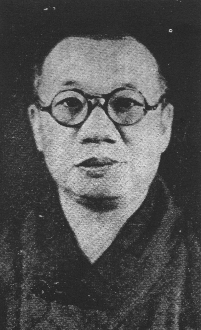Views
Dàxǐng 大醒 (1899-1952)
- Born 1899 (Guāngxù 光緒 25) in Dōngtái 東台, Jiangsu 江蘇
- Died December 13, 1952 (Mínguó 民國 41) in Táiběi 台北, Taiwan 台灣
- Lay surname: Yuán 袁[1]
Biography
From Jiangsu. At the age of 23 (in 1922), Dàxǐng graduated from Dōngtái Normal University 東台師範大學. He read Hānshān's 憨山 Mèngyóu jí 夢游集 and Yìnguāng's 印光 bestselling writings and decided to leave home. He ordained under under Xiàngzhī 讓之 at Yángzhōu's 揚州 Tiānníng Temple 天寧寺 in 1924. After ordination, he heard Tàixū 太虛 lecture and as a result entered the Wuchang Buddhist Seminary 武昌佛學院 during its second term. In the summer of 1925, he went to Lúshān 廬山 to a special camp to study Buddhism and English for propagation purposes, along with Mǎnzhì 滿智 and Huìjué 會覺. In March 1928, Dàxǐng, Zhīfēng 芝峰 and Mǎnzhì were instructed by Tàixū to take over the Minnan Buddhist Seminary 閩南佛學院 in Xiàmén 廈門. That same year Dàxǐng also started the magazine Xiàndài sēngqié 現代僧伽 (Modern Sangha), which became Xiàndài fójiào 現代佛教 (Modern Buddhism) in 1932.
In 1932, Dàxǐng and Zhifeng left the Minnan Buddhist Seminary. The following year, Dàxǐng went to Shàntóu 汕頭 in Northern Guǎngdōng, where he continued working on Xiàndài fójiào. He also began editing the Hǎicháo yīn 海潮音 the same year. In 1935, he went to Japan to look at the state of Buddhism there, and wrote a record of it when he came back. He then went back to Jiāngsū and started the Juéjīn Buddhist Seminary 覺津佛學院, which also had its own periodical. When the War of Resistance broke out in 1937, Dàxǐng organized and headed a monks’ brigade, which trained to protect Buddhism and the nation, but after the government moved, he stopped and moved to Shanghai’s Jìng'ān Temple 靜安寺.
At the end of the war, Dàxǐng became head secretary of the new Chinese Buddhist Association 中國佛教會. In summer of 1946 he succeeded Tàixū to become abbot of Zhèjiāng’s Xuědòu Temple 雪竇寺. At the beginning of 1949 he moved to Tawain, bringing the Hǎicháo yīn with him. In Taiwan, he lived at Taipei’s Shàndǎo Temple 善導寺, but high blood pressure forced him to move to Hsin-chu 新竹 in 1950. After a year he moved back. In March of 1952 he had a stroke that paralyzed half his body, and he died on December 13th.
References:
- Shì Dōngchū 釋東初. Zhōngguó Fójiào jìndài shǐ 中國佛教近代史 (A History of Early Contemporary Chinese Buddhism), in Dōngchū lǎorén quánjí 東初老人全集 (Complete Collection of Old Man Dongchu), vols. 1-2. Taipei: Dongchu, 1974 Pp. 2.901-906.
- Yú Língbō 于凌波. Zhōngguó jìnxiàndài fójiào rénwù zhì 中國近現代佛教人物志. Běijīng 北京: Zōngjiào wénhuà chūbǎnshè 宗教文化出版社, 1995. Pp. 222-229.
- Yú Língbō 于凌波, ed. Xiàndài Fójiào rénwù cídiǎn 現代佛教人物辭典 (A Dictionary of Modern Buddhist Persons), 2 vols. Taipei: Foguang, 2004. Pp. 1.56c-58c.
